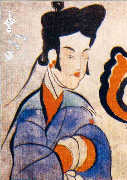 Collection of Chinese Folktales, chief-edited by Zhong Jingwen, is a reflection of the overall current states of oral folktales in China. The works selected in this book are loyal records of the excellent folktales spread among different ethnic minorities or regions. These works are characterized by vivid national characteristics and outstanding art values and are artistic gems for appreciation and collection. At the same time, they have high academic value and constitute precious materials for the research of folk literature and its relevant disciplines. Collection of Chinese Folktales is a comprehensive encyclopedia of the diverse kinds of oral folktales works among different ethnic communities of China. It is one of the most outstanding hallmarks of folklore and is a bright jewel of the treasure-trove of world cultures.
Collection of Chinese Folktales, chief-edited by Zhong Jingwen, is a reflection of the overall current states of oral folktales in China. The works selected in this book are loyal records of the excellent folktales spread among different ethnic minorities or regions. These works are characterized by vivid national characteristics and outstanding art values and are artistic gems for appreciation and collection. At the same time, they have high academic value and constitute precious materials for the research of folk literature and its relevant disciplines. Collection of Chinese Folktales is a comprehensive encyclopedia of the diverse kinds of oral folktales works among different ethnic communities of China. It is one of the most outstanding hallmarks of folklore and is a bright jewel of the treasure-trove of world cultures.
Collection of Chinese Folktales covers diverse subjects and styles of oral literature, among which there are myths, legends and various tales including animal tales, imaginary tales, life tales, and folk jokes. It consists of 30 volumes with over 45,000,000 words, each of which is about 1.5 million words with a large number of colored illustrations.
Collection of Chinese Folktales has been published 23 volumes and is to be completed by 2005.
 Myths
Myths
 |
|
Nuwa
|
Myths are the main literature form of mankind in prehistory, and people's "unconscious" artistic creations. There are many myths kept in the ancient Chinese classics such as Zhuangzi, Haifeizi, Biography of Motianzi, Chuci, and Shanhaijing. To this day, there have still been a lot of oral narrative myths popular among all ethnic groups in China.
The genesis myths, interpreting the origin and structure of the universe, hold that the Heaven and the Earth have existed naturally and the formation of everything in the universe is a process. As The Origin of the World, a myth of Yi ethnic group goes: in the time immemorial, there were no heaven and earth and the world was in chaos, which were then divided by wind into heavy air 1and light air. Then the light air floated upwards and formed heaven and Yang elements; while the heavy air fell downwards and formed earth and Yin elements. When Yin and Yang met, they produced the colors of blue, red and yellow. Another myth holds that the heaven and the earth were given birth by a genesis goddess or a creature.
The origin of man is one of the puzzles that our ancestors wanted to solve. There are different views about human origin: one popular myth holds that man was created with clay; and another that man was born by a creature.
The ancestors of different ethnic groups in China regard their material myths as myths of cultural origins, among which the myths about the origins of fire and grains are most famous.
 |
|
Da Yu
|
In Chinese myths, Nuwa is the creation deity and the heaven-repairing heroine. It was said that there was no creature in the world at the beginning of the genesis. Thus, Nuwa made humans with clay. Soon after that, there was a collapse of the northwest sky followed by gales, heavy rain, snow and hail, and the world was suffering from flood. Seeing this, Nuwa began to repair the sky with stones of five colors and then adjusted the four sky poles in place, which enabled the people to live a happy and peaceful life again.
The flood myths are also popular among the ethnic groups in southwest China such as Miao, Zhuang, Yao, Bai, Dai, Hani, Lisujingpo, Buyi, Bulang, Naxi, Lahu, Benglong, Pumi and Achang ethnic groups. These myths relate that the ancient ancestors offended the deities and the God of the Heaven punished them by creating disastrous floods. Only a sister and a brother survived the floods by hiding in a gourd or other flood-proof tools. Later, they got married under the direction of the God and became the ancestors of human beings.
